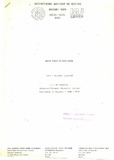| dc.description.abstract | KIBERA
1. -B-a-c-krg-r-o-u-n-d
The majority of the residents of Kibera are Nubians who are
descendants of Sudanese soldiers who had joined the'British
I army. They were settled in Kibera between 1912 and 1934 by the
colonial administration and each was given a plot as a reward
for their services. The rest of the other races (Kikuyu, Kamba,
etc) started moving in, in 1956 as squatters. They occupied the I .
outlying fringes~f Kibera near Nairobi dam or the lower slopes
of MutoiThi river valley.
With the extending of the city boundary, just before independence
Kibera became part of Nairobi. A number of proposals were made I
by the City Council to develop Kibera but it became very difficult
because of the land ownership problem. The Nubians claimed
this land to be theirs and yet there were no records or title
deeds which they pould use as their proof. The colonial government
allocated the land to them but gave no document to show that
they were the rightful owners of the land. Up to date the situation
has remained unclear as to who is the rightful owner of the
land in Kibera.
2. Population and People
Since 1912 Kibera has been associated with Nubian community in
Kenya. Throughout its history it has been an area of low-income
settlement. Since 1970 its population has grown very rapidly
partly as a result of Nairobi's rapid urbanisation to become
Nairobi's second major concentration of low-~ncome inhabitants \
after Mathare Valley.
,
Population Estimates
+917 000
\ | en_US |



